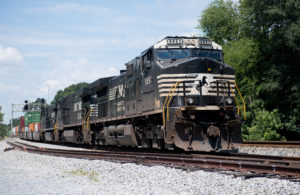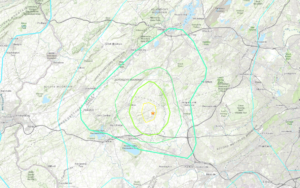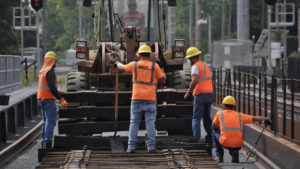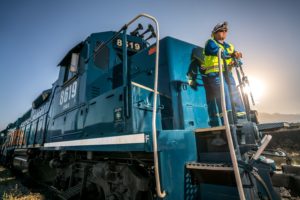Transportation Safety Board of Canada reports on fatal Canadian Pacific 2019 derailment – CP pushes back
Written by David C. Lester, Editor-in-Chief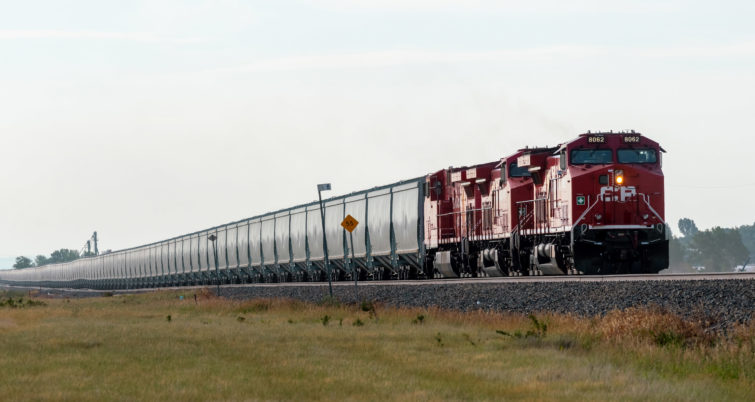
Last week, the Transportation Safety Board of Canada (TSB) released its investigation report (R19C0015) into the 2019 derailment of two locomotives and 99 cars of a 112 car grain train, in which the three crew members were fatally injured near Field, B.C. CP disputes aspects of the report.
The derailment
Last week, the Transportation Safety Board of Canada (TSB) released its investigation report (R19C0015) into the 2019 derailment of two locomotives and 99 cars of a 112 car grain train, in which the three crew members were fatally injured near Field, B.C. As a result of the investigation, the TSB has issued three recommendations to make cold-weather train operations safer through mountainous territory.
The Board recommends that Transport Canada (TC):
- establish enhanced test standards and requirements for time-based maintenance of brake cylinders on freight cars operating on steep descending grades in cold ambient temperatures. (TSB Recommendation R22-01)
- require Canadian freight railways to develop and implement a schedule for the installation of automatic parking brakes on freight cars, prioritizing the retrofit of cars used in bulk commodity unit trains in mountain grade territory. (TSB Recommendation R22-02)
- require Canadian Pacific Railway Company (CP) to demonstrate that its safety management system can effectively identify hazards arising from operations using all available information, including employee hazard reports and data trends; assess the associated risks; and implement mitigation measures and validate that they are effective. (TSB Recommendation R22-03)
“This tragic accident demonstrates, once again, that uncontrolled movements of rolling stock continue to pose a significant safety risk to railway operations in Canada”, said TSB Chair Kathy Fox. “It is obvious that more must be done to reduce the risks to railway employees and the Canadian public, reduce preventable loss of life, and increase the safety and resilience of this vital part of the Canadian supply chain.”
The investigation findings also reflect the TSB’s ongoing concerns about unplanned/uncontrolled movements of rail equipment and safety management, both of which are issues on the TSB Watchlist.
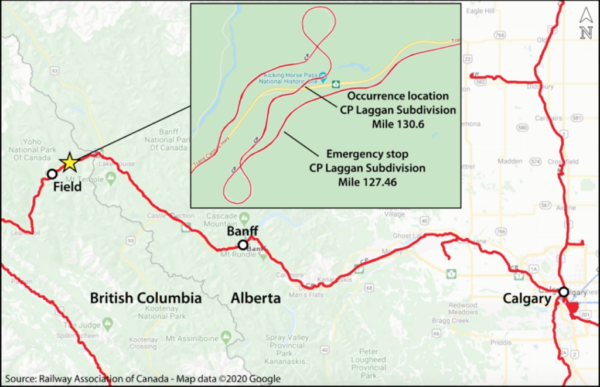
The occurrence
On 3 February 2019, a CP unit grain train with 112 loaded hopper cars was traveling from Calgary, AB to Vancouver, BC. While descending the steep 13.5-mile-long Field Hill, the inbound train crew was not able to maintain the required speed and applied the brakes in emergency, bringing the train to a stop at 9:49 pm. The brake cylinder pressure retaining valves were set on 84 cars to retain residual air pressure, which would facilitate getting the train underway again, allowing the air brakes to recharge as it continued its descent. A relief crew was called in to replace the inbound crew as they were at the end of their shift. During this time, the train’s air brake system had been leaking brake cylinder pressure, reducing the capacity to keep the train stopped on the grade. Shortly after the relief crew took over, at 12:42 am on 4 February, the train began to creep forward and accelerate uncontrolled down the steep grade. The train reached 53 mph, and was unable to negotiate a sharp curve, resulting in the derailment of two locomotives and 99 cars, and the three relief crew members being fatally injured.
Investigation findings
The investigation found that the brake cylinders on the freight cars were leaking compressed air, a situation made worse by their age and condition, and exposure to extreme cold temperatures over time. It was determined that after being stationary on the hill for around 3 hours, air leakage reached a critical threshold and the brakes could no longer hold the train on the steep grade.
The inbound locomotive engineer had observed indications of brake system anomalies. Although these were discussed with the trainmaster, they were not recognized as problematic. Additionally, because the situation was the first emergency stop, critical factors were not considered, and only the pressure retaining valves were applied, rather than the retaining valves and hand brakes. In this instance, the trainmaster’s training and experience did not adequately prepare him to evaluate the circumstances or to make the decision he was tasked with.
The TSB also issued 3 Rail Safety Advisories to communicate safety critical information to Transport Canada as the investigation was unfolding. Those advisories urged Transport Canada to address the following deficiencies:
- the adequacy of braking performance of grain cars in CP’s fleet,
- residual risk for trains stopped in emergency on grades less than 1.8%,
- the need for an alternate approach to determine the effectiveness of freight car air brakes.
Following the occurrence, TC introduced several initiatives, and CP proceeded, among other things, to remove over 5000 grain cars from service for repair. Safety actions taken by both parties are detailed in the investigation report.
See the investigation page for more information.
CP push-back
Last week, CP issued the following statement regarding the Transportation Safety Board (TSB) investigation report (Report) into the Feb. 4, 2019 derailment that tragically took the lives of three CP railroaders.
CP continues to mourn the loss of Dylan Paradis, Andrew Dockrell and Daniel Waldenberger-Bulmer. This is a tragedy that will never be forgotten and one which has strengthened CP’s unwavering commitment to safety across its entire operation.
Given the gravity of this incident and the tragic loss of life, it was extremely disappointing that the TSB misrepresented the facts at last week’s news conference and misunderstood key facts about the incident in its Report. Specifically:
- At the news conference, the TSB’s Manager, Head Office and Western Regional Operations – Rail, misrepresented what happened on the locomotive when the relief crew arrived to relieve the inbound crew. The relief crew did not immediately decide to apply handbrakes upon arriving at the locomotive. The Report itself contradicts his statement. Per the TSB report, the relief crew had been on board the locomotive for over 20 minutes and had performed another job briefing before the train started to move. No decision to apply handbrakes was made during this time.
- The assessment of the situation and the decision to apply brake retainers were made using the collective knowledge and experience of everyone involved. Both the locomotive engineers of the inbound crew and the relief crew were fully-trained, qualified and certified, and were well-experienced in the handling of trains on mountain grades. The trainmaster was also a qualified locomotive engineer with experience on mountain grades. Both crews and trainmaster agreed on the appropriate steps to be taken in line with existing procedure. The Field Hill operating procedure itself was based on operating practices established in collaboration with the running trades employees, Transport Canada and company management in the wake of previous incidents more than two decades ago. This was not an issue of training and/or experience.
- The TSB has erroneously concluded, based on inappropriate extrapolation of data and unsupported inferences, that the involved-train exhibited poor braking performance. As confirmed in the Report, the train involved in the incident was fully functional, met all industry standards and passed all regulatory brake test inspections.
- CP demonstrated that its Safety Management System contains all of the necessary elements as required by regulations. CP’s safety hazard reporting procedure was effective, both in form and in execution. There were no systemic hazards that were not appropriately addressed, including Field Hill train braking performance, by CP’s Safety Management System.
- CP has a robust training and certification program that meets or exceeds applicable regulatory standards, utilizing leading technology and focusing on practical application. Learning at CP is never complete, and CP’s training programs are continuously being updated and refined using the most current practices and learnings to confirm complete understanding.
CP has a strong culture of safety and always works to improve. CP remains the industry leader in technology-driven train inspections with a decade-long track record of reduced train accidents and improved train performance.
Throughout this investigation, CP fully cooperated with the TSB. CP strongly believes that real and substantive safety improvements are only achieved when fact-based and objective analysis is undertaken to truly understand the causes and contributing factors of an incident like the Field derailment.
CP will be addressing the inaccuracies and misrepresentations made at last week’s news conference and in the Report in greater detail directly with the TSB.
This matter remains the subject of a preliminary inquiry by the RCMP.
For brief news updates and commentary, please follow me on Twitter at @davidclesterRTS

